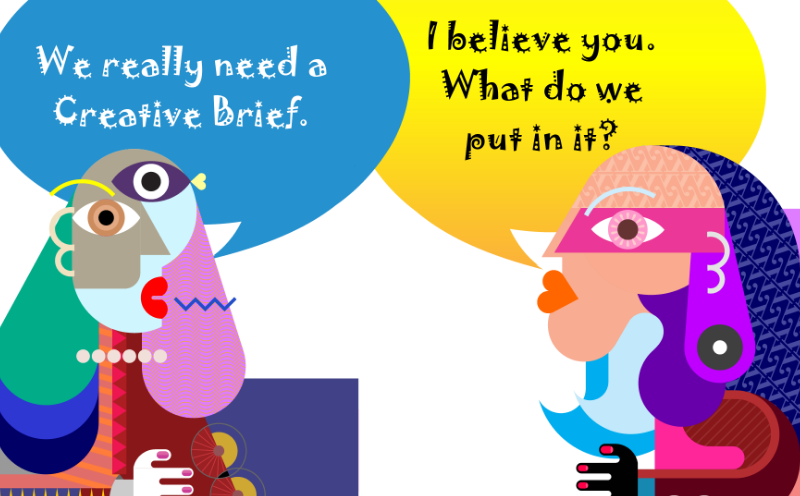A creative brief is one of the foundational planning documents of any marketing project. It’s more specific (and easier to produce) than a marketing plan. It’s meatier than a schedule. It’s more nuanced than a style guide. Most important, it’s what keeps everyone on the same page during the creative process.
If a marketing plan is a map of your marketing’s brain, a creative brief is its beating heart.
While a creative brief can take many forms, there are a few components that are important to include.
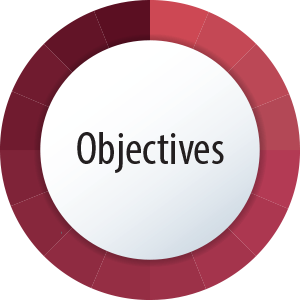 Objectives. The first part of a creative brief is a very short, very clear list of objectives. Your objectives should include long-term as well as short-term objectives, for this reason: When you keep your long-term objectives in mind while meeting short-term needs, you save money and time — in that order. A great example is what happens when you have a panic project. In other words, a few minutes spent writing one extra sentence could save you thousands of dollars. So do that.
Objectives. The first part of a creative brief is a very short, very clear list of objectives. Your objectives should include long-term as well as short-term objectives, for this reason: When you keep your long-term objectives in mind while meeting short-term needs, you save money and time — in that order. A great example is what happens when you have a panic project. In other words, a few minutes spent writing one extra sentence could save you thousands of dollars. So do that.
 Business problem to to be solved. All marketing starts here. While it may seem basic, defining the business problem in a couple of short paragraphs helps to keep everyone focused. Better still, the very act of writing it helps clarify issues that you probably wrestle with all the time, but have never articulated, or at least never written down.
Business problem to to be solved. All marketing starts here. While it may seem basic, defining the business problem in a couple of short paragraphs helps to keep everyone focused. Better still, the very act of writing it helps clarify issues that you probably wrestle with all the time, but have never articulated, or at least never written down.
Offers. Whi le you don’t think of “offers” in a traditional sense in all industries – for example, there’s no BOGO in consulting or financial services – there are appropriate and effective offers for every business, organization, and target audience. What are you going to give prospects in exchange for their interest, their contact information, or for that most precious commodity of all, their time? That’s your offer.
le you don’t think of “offers” in a traditional sense in all industries – for example, there’s no BOGO in consulting or financial services – there are appropriate and effective offers for every business, organization, and target audience. What are you going to give prospects in exchange for their interest, their contact information, or for that most precious commodity of all, their time? That’s your offer.
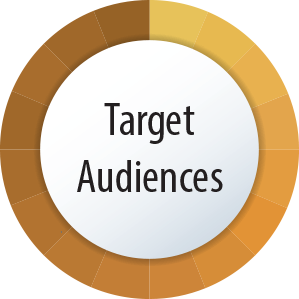 Target Audiences. This is a short list of the target audiences that are discussed at greater length and depth in your Marketing Plan. For general marketing, repeating them in the creative brief is a handy shortcut, and a way to communicate them to vendors and others when it’s not appropriate to share the entire Marketing Plan. It’s also where you will refine your targets for specific projects, for example, “parents of children ages 10-18 within a 15-mile radius of the Phoenix tutoring center”, or “C-suite tech executives in the Boston metro area”.
Target Audiences. This is a short list of the target audiences that are discussed at greater length and depth in your Marketing Plan. For general marketing, repeating them in the creative brief is a handy shortcut, and a way to communicate them to vendors and others when it’s not appropriate to share the entire Marketing Plan. It’s also where you will refine your targets for specific projects, for example, “parents of children ages 10-18 within a 15-mile radius of the Phoenix tutoring center”, or “C-suite tech executives in the Boston metro area”.
 Timing/Target Dates. This is an overview of key deadlines. Although you’ll create a separate schedule with detailed specifics, include the most important milestones here, so they’re addressed early on. For example, let’s say your product launch is July 1. If you want sales to begin that day, you might have a marketing and lead-in launch a few weeks before that, a ship date before that, and packaging ordered from the vendor weeks before that.
Timing/Target Dates. This is an overview of key deadlines. Although you’ll create a separate schedule with detailed specifics, include the most important milestones here, so they’re addressed early on. For example, let’s say your product launch is July 1. If you want sales to begin that day, you might have a marketing and lead-in launch a few weeks before that, a ship date before that, and packaging ordered from the vendor weeks before that.
 Positioning. This defines how you want your clients to think about you in comparison to competitors. If you were a car, would you be Tesla, a Jaguar, or a Honda Fit? If you were a vacation, would you be a luxury hotel, a Disney resort, or a camping experience? Communicating positioning correctly helps your prospects to understand your USP (unique selling proposition) more intuitively and helps them skip to the buying part. For the purposes of the creative brief, it helps to make sure that everyone on the team has the same vision in mind as they’re creating their part of the project
Positioning. This defines how you want your clients to think about you in comparison to competitors. If you were a car, would you be Tesla, a Jaguar, or a Honda Fit? If you were a vacation, would you be a luxury hotel, a Disney resort, or a camping experience? Communicating positioning correctly helps your prospects to understand your USP (unique selling proposition) more intuitively and helps them skip to the buying part. For the purposes of the creative brief, it helps to make sure that everyone on the team has the same vision in mind as they’re creating their part of the project
 Key Messages. There are a lot of great things to say about your product or service, but no prospect can remember everything. This is where you will spell out the handful ideas that you want them to remember most. Write down one to five key messages — but no more than five. Use short phrases or single sentences, and put them in priority order.
Key Messages. There are a lot of great things to say about your product or service, but no prospect can remember everything. This is where you will spell out the handful ideas that you want them to remember most. Write down one to five key messages — but no more than five. Use short phrases or single sentences, and put them in priority order.
 Competition. The other guys. This should be a brief list or discussion, not an exhaustive overview. A more detailed description of your competitors can go in your marketing plan, or a marketing plan’s addendum.
Competition. The other guys. This should be a brief list or discussion, not an exhaustive overview. A more detailed description of your competitors can go in your marketing plan, or a marketing plan’s addendum.
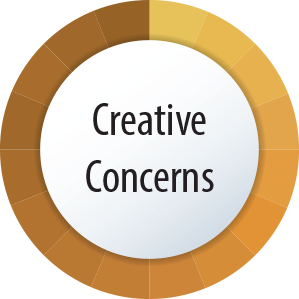 Creative Considerations. Your style guide covers colors, fonts, logo usage, and other stylistic and identity elements. But here’s where you add additional notes that apply especially, or only, to this project. These might include, for example, colors, images, or styles to avoid because they’re used by a competitor.
Creative Considerations. Your style guide covers colors, fonts, logo usage, and other stylistic and identity elements. But here’s where you add additional notes that apply especially, or only, to this project. These might include, for example, colors, images, or styles to avoid because they’re used by a competitor.
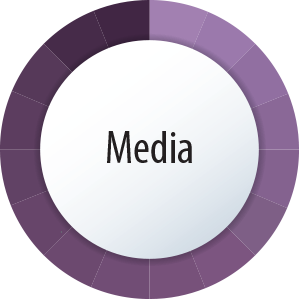 Media. List all the specific media that will be used in the projects covered by the creative brief. That includes broadcast, print, outdoor, earned, social, digital ads, and direct mail, but also media like outdoor, point-of-sale, trade show, sales support materials, and more.
Media. List all the specific media that will be used in the projects covered by the creative brief. That includes broadcast, print, outdoor, earned, social, digital ads, and direct mail, but also media like outdoor, point-of-sale, trade show, sales support materials, and more.
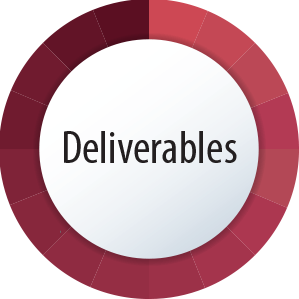 Deliverables. These are the end-products you’ll get when the creative work is done. It’s the “stuff” that you can see, use, share, and sometimes touch. Spelling it out helps you to know what to expect, and makes it easier for vendors to give you accurate estimates and correct formats (for example, if a designer knows that you’re planning to use an image created for a slide presentation later in video or a billboard, they’ll create the image in a larger size and higher resolution so it will work for all those needs).
Deliverables. These are the end-products you’ll get when the creative work is done. It’s the “stuff” that you can see, use, share, and sometimes touch. Spelling it out helps you to know what to expect, and makes it easier for vendors to give you accurate estimates and correct formats (for example, if a designer knows that you’re planning to use an image created for a slide presentation later in video or a billboard, they’ll create the image in a larger size and higher resolution so it will work for all those needs).
Depending on your project, your deliverables list might include a specific number of digital ads or social media posts, a slide presentation, print ads, direct mail, landing pages, etc. Check your deliverables list against your media list to make sure they match. Are you asking for enough content, and enough types of content, for all the media you plan to use? Are you asking for more than you need, putting unnecessary pressure on your schedule and budget? This is the place, and now is the time, to streamline your project and prevent problems.
Master Creative Brief vs. Project Creative Brief
Most clients have two kinds of creative briefs: a master creative brief that covers projects overall, and a project creative brief that covers just one project, or a small number of related projects. A master creative brief can be useful, with minor updates, for as long as a few years. Project creative briefs can then be created quickly as simple variations on the master.
Pro tip: When modifying a master creative brief for a project, read the entire document to make sure you don’t have to adjust other sections (objectives, positioning, audience, etc.) in addition to the obvious ones (media, deliverables). Half an hour of review and light editing can avoid results that can include confusion, embarrassment, accidental hilarity, or in the worst-case scenario, schedule delays and expensive miscommunications.
Here are some things an effective creative brief is not:
In the olden days, before the Internet and GPS, the most stolen book in the United States was the Bible. This is either ironic or soul-saving, depending on your point of view. But that was not true in California, where the most stolen book was a spiral-bound road atlas called The Thomas Guide. Nearly everyone who lived in California had a Thomas Guide in their car. Thomas Guides were never forgotten on bookshelves or left around, pristine. They fell apart from constant use. (Thomas Guides are still published, BTW, if you prefer maps to apps.)
Like the Thomas Guide, a creative brief is meant to be used, a lot. Everyone who works on a project should have it. Project leads, creative directors, designers, copywriters, production managers, and senior stakeholders all need to refer to it at multiple stages of the project. In order to be useful, it must be:
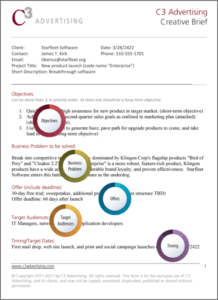
Brief. Focus on key points. Include important reminders and top-line conclusions. You may have spent weeks in research and strategizing before you decided to target Spanish-speaking 30-year-olds who love to travel, but don’t include all that detail here in the creative brief. It just clutters the document and makes it difficult to use.
Clean, airy, and easy to read. Use plenty of white space, call out subheads or topics in color, and organize material in bulleted or numbered lists.
Easy to understand and use. It should go without saying that your creative brief, like any planning document meant to communicate instructions or guidelines, should be well-written and free of jargon. (Including lots of jargon or mysterious acronyms does not make you sound cool in this context, because your job is communicating.)
But there’s another reason to go the extra mile for clarity. Experienced marketers in large companies, and creative professionals, will all understand exactly how to use a creative brief. That might not be the case for smaller organizations. In addition to the example shown here, we have another template that includes a brief, well-organized introduction that explains each section, why it’s there, and how to use the document.
As I said earlier, a creative brief can take many forms. (If you’ve got a different approach to a creative brief, please share your perspective in the comments.) But however you write one, if you take the time to make sure you’ve covered the basics, your marketing projects will go much more smoothly at every step of the process. And that’s a good thing for your budget, your team, and most importantly, for your results.

